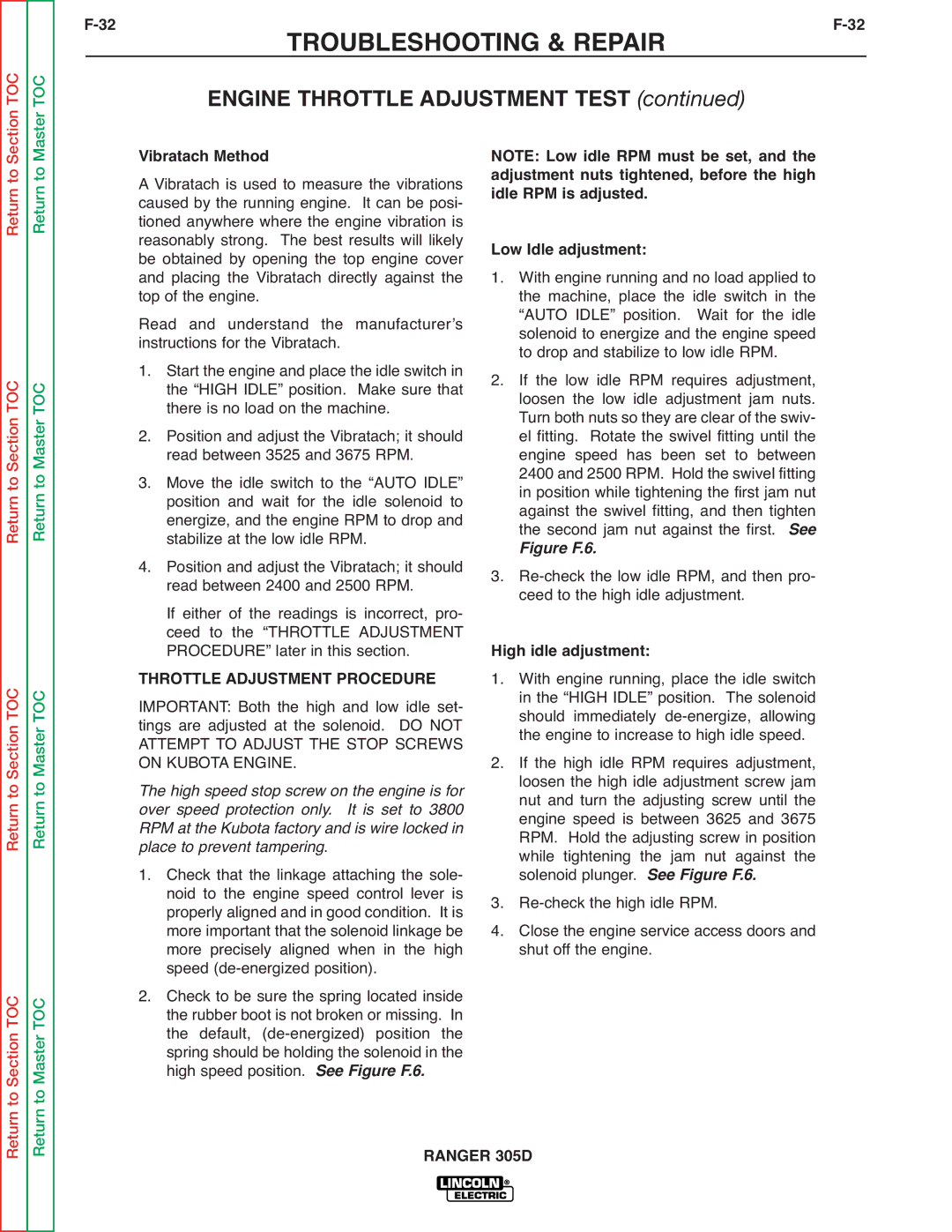
TOC
TOC
TROUBLESHOOTING & REPAIR | |||
|
| ENGINE THROTTLE ADJUSTMENT TEST (continued) |
|
Return to Section
Return to Section TOC
Return to Section TOC
to Section TOC
Return to Master
Return to Master TOC
Return to Master TOC
to Master TOC
Vibratach Method
A Vibratach is used to measure the vibrations caused by the running engine. It can be posi- tioned anywhere where the engine vibration is reasonably strong. The best results will likely be obtained by opening the top engine cover and placing the Vibratach directly against the top of the engine.
Read and understand the manufacturerʼs instructions for the Vibratach.
1. Start the engine and place the idle switch in the “HIGH IDLE” position. Make sure that there is no load on the machine.
2. Position and adjust the Vibratach; it should read between 3525 and 3675 RPM.
3. Move the idle switch to the “AUTO IDLE” position and wait for the idle solenoid to energize, and the engine RPM to drop and stabilize at the low idle RPM.
4. Position and adjust the Vibratach; it should read between 2400 and 2500 RPM.
If either of the readings is incorrect, pro- ceed to the “THROTTLE ADJUSTMENT PROCEDURE” later in this section.
THROTTLE ADJUSTMENT PROCEDURE IMPORTANT: Both the high and low idle set- tings are adjusted at the solenoid. DO NOT ATTEMPT TO ADJUST THE STOP SCREWS ON KUBOTA ENGINE.
The high speed stop screw on the engine is for over speed protection only. It is set to 3800 RPM at the Kubota factory and is wire locked in place to prevent tampering.
1. Check that the linkage attaching the sole- noid to the engine speed control lever is properly aligned and in good condition. It is more important that the solenoid linkage be more precisely aligned when in the high speed
2. Check to be sure the spring located inside the rubber boot is not broken or missing. In the default,
NOTE: Low idle RPM must be set, and the adjustment nuts tightened, before the high idle RPM is adjusted.
Low Idle adjustment:
1. With engine running and no load applied to the machine, place the idle switch in the “AUTO IDLE” position. Wait for the idle solenoid to energize and the engine speed to drop and stabilize to low idle RPM.
2. If the low idle RPM requires adjustment, loosen the low idle adjustment jam nuts. Turn both nuts so they are clear of the swiv- el fitting. Rotate the swivel fitting until the engine speed has been set to between 2400 and 2500 RPM. Hold the swivel fitting in position while tightening the first jam nut against the swivel fitting, and then tighten the second jam nut against the first. See
Figure F.6.
3.
High idle adjustment:
1. With engine running, place the idle switch in the “HIGH IDLE” position. The solenoid should immediately
2. If the high idle RPM requires adjustment, loosen the high idle adjustment screw jam nut and turn the adjusting screw until the engine speed is between 3625 and 3675 RPM. Hold the adjusting screw in position while tightening the jam nut against the solenoid plunger. Seeidle Figure F.6.
3.
4. Close the engine service access doors and shut off the engine.
Return
Return
